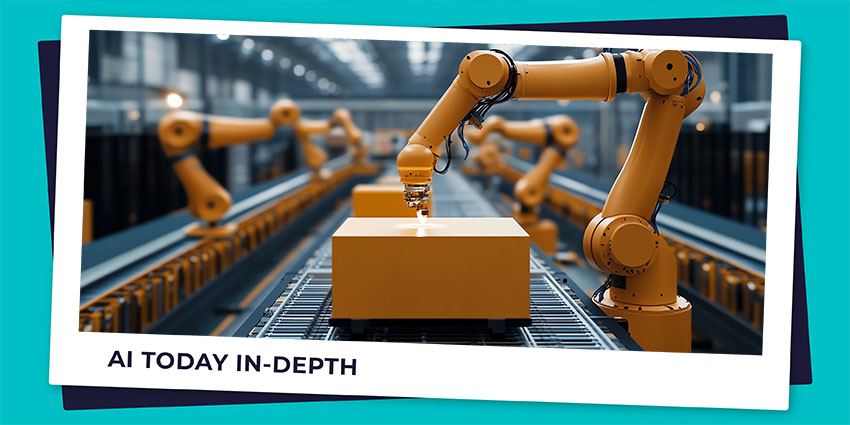The manufacturing industry has long stood as one of the fastest adopters of new technologies. Over the decades, we’ve evolved from constructing products by hand to enabling faster, more efficient mass production techniques with robotics and machines. Now, AI in manufacturing is introducing the dawn of a new age.
Since 2019, Industry 4.0 adoption has jumped by over 80%, as companies look for new ways to streamline processes, reduce costs, and innovate with cutting-edge tech. As AI solutions grow increasingly powerful, they’re empowering manufacturing brands in all sectors to accomplish significant goals, from minimizing factory floor risks to improving supply chain performance.
Artificial intelligence will become a fundamental part of the manufacturing technology stack in the years ahead. More than 66% of manufacturers already use AI for some of their daily operations today. So, what does AI in manufacturing look like now, and what will it mean for the future of our factories?
What is AI in Manufacturing?
AI in manufacturing uses artificial intelligence solutions, such as machine learning, deep learning neural networks, and robotics to optimize manufacturing processes. AI-powered tools can perform various human-like tasks in the manufacturing sector, from analyzing system processes and anticipating issues to streamlining quality control.
While artificial intelligence’s versatility makes it a valuable resource for companies in every industry, the manufacturing sector is particularly well-suited to AI adoption. After all, according to Deloitte, the manufacturing industry generates more data than virtually any other sector.
Since data is the lifeblood of AI, the manufacturing space has the potential to not only leverage AI effectively, but also contribute to the future development of more effective bots and tools.
Already, early AI adopters have discovered numerous use cases for AI in manufacturing. Supply chain management has transformed with the use of machine learning algorithms, which help to estimate demand and simplify logistics. AI robotics are enhancing assembly lines, contributing to faster, more accurate product development.
AI can even help predict and autonomously prevent machine failure, minimizing downtime, and helping companies to stay competitive in a fast-paced space.
Key Segments of AI in Manufacturing
Artificial Intelligence is a broad concept, and it’s growing broader all the time, with new innovations like LLMs (Large Language Models), generative AI, and quantum learning. Various aspects of AI benefit the manufacturing space. Generative AI can help businesses with product design, predicting market trends, and factory planning, for instance.
On a broad scale, the most significant segments of AI impacting manufacturing companies today include:
- Machine learning: With machine learning, companies can leverage algorithms and data in AI systems to enable devices to learn from underlying patterns and historical information. This allows for better forecasting, machine development, and preventative maintenance.
- Deep learning: Building on the benefits of machine learning, deep learning solutions leverage neural networks, for more in-depth data analysis. Companies use deep learning for product development, quality assurance, and supply chain management.
- Autonomous objects: AI can enable manufacturing companies to create machines that can operate on their own, without human input. We’ve seen this concept developing in the landscape of autonomous vehicles, and collaborative robots.
AI in Manufacturing: Use Cases and Examples
As AI solutions grow increasingly advanced and intuitive, the manufacturing industry is taking note. In fact, some studies show that the market for AI in manufacturing is currently growing at an incredible CAGR of 41.5%. Here are some of the top use cases and examples of AI in the manufacturing space today.
1. Cobots: Collaborative Bots
Robotics has been shaping the future of the manufacturing industry for some time now. The solutions available to companies come in various forms, from fully autonomous machines that can complete tasks, detect problems, and implement fixes without human input, to collaborative bots.
Cobots, or collaborative bots, work alongside human operators to streamline manufacturing tasks. They work in unison with employees on processes like picking and packing. For instance, Amazon, one of the world’s leading companies, uses Cobots enhanced with machine learning to expedite order fulfillment processes, and reduce operational costs.
Cobots can handle more intricate assembly processes, as well as quality assurance tasks than most fully automated solutions. They can help businesses reduce downtime and maintenance costs, while keeping equipment functioning effectively.
2. Enabling Predictive Maintenance
Predictive maintenance has emerged as one of the most valuable use cases for AI in manufacturing. In fact, the market for predictive solutions is set to reach a value of $47.8 billion by 2029. Software solutions can leverage machine learning and deep learning algorithms to proactively monitor equipment, predict failures, and even apply autonomous fixes to issues.
In recent years, the evolution of predictive maintenance has been enhanced by metaverse and XR concepts, like the digital twin. Digital twins offer companies an opportunity to create virtual replicas of physical assets and processes, capturing real-time data. With these tools, companies can rapidly analyze patterns in machine performance, and identify anomalies in advance.
Already, some of the world’s leading manufacturing companies are experimenting with this concept. Ford, for instance, creates digital twins for every vehicle model it produces. It also uses digital models to analyze and optimize production facilities and manufacturing procedures. More than just a way to reduce downtime, predictive maintenance can help businesses accelerate their time to market, optimize maintenance schedules, and even reduce risks on the factory floor.
3. Supply Chain Management
Similar to predictive maintenance, supply chain optimization is another key use case for AI in manufacturing. Supply chains are growing increasingly complex in an age of rapid globalization, and artificial intelligence can help businesses improve efficiency, accuracy, and cost-effectiveness.
In the supply chain, AI solutions allow companies to leverage predictive analysis, optimize inventory management, monitor logistics processes, and forecast demand. Machine learning algorithms can analyze historical data at scale, identify patterns, and accurately predict the steps businesses need to take to stay ahead of market trends.
Many of the world’s biggest companies, such as Walmart, use artificial intelligence in their supply chain processes to maximize productivity and increase customer satisfaction. Retail giants use machine learning algorithms to evaluate previous sales data, and optimize inventory levels based on forecasted demand. Companies even use AI in the logistics space, to optimize delivery routes, container allocation, and other strategies, enhancing global trade.
4. Product Development and Improvement
As mentioned above, manufacturing brands are using various forms of AI to influence how they create products in today’s world. Without AI, we wouldn’t have the tools necessary to experiment with new ideas, such as autonomous vehicles and smart wearables.
The integration of AI into the manufacturing industry gives companies the freedom to explore new ways of creating and introducing products to the market. Not only can AI help businesses identify novel ideas for products, based on the analysis of huge volumes of data, but it can use that data to ensure businesses invest in products with the most potential to succeed.
Using insights into customer preferences, trends, and competitors, machine learning models can guide businesses towards data-driven launch decisions. AI can even help companies improve how they build products, identifying areas in factory processes to improve or streamline.
Thanks to the rise of generative AI, firms now also have access to cutting edge “generative design software”, which can create blueprints, guides, and outlines for businesses to follow. Even market leaders like NVIDIA use machine learning algorithms to optimize semiconductor layouts, and reduce expenses in product development.
5. Assembly Line Optimization
I mentioned this briefly in the previous section, but AI’s impact on the manufacturing assembly line can be phenomenal. Assembly lines can be complex to optimize in the manufacturing space. Even a single error or inefficiency can lead to huge delays and disruptions. By analyzing real-time sensor data and previous performance metrics, AI can help boost efficiency.
The right AI tools can reduce downtime, and enable predictive maintenance for crucial machinery. They can also help companies to modify production parameters, based on variations in demand, reducing waste and improving resource allocation. AI systems with powerful computer vision capabilities can even automate or augment the quality assurance process.
With computer vision, machines can identify defects, or anomalies in products as they move through the production line with incredible precision. Evolutions in AI trends are even leading to the development of “predictive quality assurance” solutions, that can use historical data to determine which products are flawed in advance, reducing wasted resources.
These quality assurance capabilities can be particularly valuable in certain sectors of the manufacturing space. For instance, in pharmaceutical manufacturing, AI tools can analyze protein and molecule structures in medications, and determine which products may be dangerous or ineffective.
6. Inventory, Warehouse and Order Management
We’ve already seen plenty of examples of AI helping to optimize the management of offices and teams. In the manufacturing sector, AI can revolutionize various management processes, from inventory and warehouse to order management.
In the inventory and warehouse management landscape, AI algorithms can analyze previous sales data, market trends, and current stock levels to predict demand patterns accurately. This ensures companies can adjust their inventory levels according to demand, reducing the risk of overstocking and understocking.
Companies like BMW in the automotive industry use AI-managed robots, and AI algorithms to constantly adapt production volumes according to changing market trends. This helps the company keep costs low, and profits high.
In the order management space, AI can help businesses process orders more effectively, update inventory information, and even make dynamic pricing changes. Based on both historical and real-time data, AI systems can ensure businesses know how to position their products to increase sales, conversions, and revenue, while maintaining customer satisfaction.
AI can even help with reducing risks in order management, analyzing purchases for evidence of fraud or malicious activity. As the consumer world continues to face an ever-increasing range of threats from fraudulent actors, these capabilities will become increasingly important. Businesses will rely on AI to spot everything from deepfakes, to scam orders.
7. Performance Optimization and Task Automation
The manufacturing industry is a sector that relies on consistent efficiency, speed, and productivity. Even the smallest performance issue can lead to billions in lost revenue. Aside from analyzing processes and enabling predictive maintenance, AI in manufacturing can offer businesses a huge range of ways to automate tedious tasks.
Robotic Process Automation (RPA) software is fantastic at handling high volume, repetitive tasks, from transferring data across systems, to managing calculations and queries. It eliminates the need for companies to enter, track, and manage the large volumes of data they produce manually. Not only does this reduce operational costs for organizations, but it can offer other benefits too.
The automation of repetitive tasks can help businesses to minimize downtime and disruptions. For instance, RPA can help to mitigate server issues for growing companies. Plus, automated systems can reduce the risks associated with errors in the manufacturing space. Unlike human beings, machines aren’t as likely to make mistakes due to fatigue with tedious processes.
RPA solutions can even streamline the management of paperwork processes involving purchase orders, invoices, and quality control reports. Some solutions with conversational AI capabilities can even automatically extract, classify, and categorize data from documents, before entering it into appropriate systems.
8. Sales and Marketing Enhancement
I’ve already noted that AI solutions are excellent at predicting demand, understanding customer preferences, and helping businesses adapt to market trends. AI in manufacturing can also help businesses to improve their sales and marketing strategies, unlocking additional revenue and opportunities. For instance, based on analysis of market trends, a manufacturing company can determine when to host promotional sales, or offer discounts to customers.
Generative AI and conversational AI solutions can help businesses create personalized marketing and sales strategies for different groups of consumers. They can even empower businesses to send instant, personalized messages to consumers based on their previous purchases, or browsing data.
For example, an AI bot built into a manufacturer’s website can assess the pages on the site a customer visits, and proactively send a message to help direct them to the right solution. These bots can also have a significant impact on customer service, answering customer questions automatically, and simplifying the search for knowledge.
The positive impact AI has on customer experience can lead to significant increases in sales. Plus, it can help to increase brand loyalty and customer retention, making manufacturing companies more resilient and profitable.
9. Connected Factories
Finally, connected factories, leveraging IoT, AI, and machine learning, are an excellent example of how AI in manufacturing can transform the world. Companies can use a range of AI solutions to build intelligent, networked ecosystems, bridging the gaps between employees, processes and tools.
The networked system enables machine-to-machine communication on a massive scale. This allows companies to implement quick changes to production schedules based on risks or changes in demand. The connected systems can also offer manufacturing businesses access to more comprehensive real-time data from machinery and factory floors.
With a more holistic view of all factories working in unison, companies can implement more effective predictive maintenance schedules, improve operational efficiency, and reduce costs. For example, General Electric uses artificial intelligence and IoT to monitor equipment health, track production lines, and make global upgrades to its processes.
The Future of AI in Manufacturing
Although AI has already had a profound impact on the manufacturing space, there’s still plenty of room for growth. Evolutions in machine learning, deep learning, and AI algorithms will make future systems more effective at predicting trends and enhancing product design.
Additionally, AI will empower manufacturing companies to tackle significant challenges in the sector, such as implementing more sustainable, eco-conscious practices. Studies have already shown that AI can help organizations become more energy efficient, by determining which areas consume the most resources, and introducing ideas for improvement.
As global governments and regulatory groups continue to crack down on waste and high energy consumption, AI will help to transform the future of “sustainable manufacturing”. However, it’s worth noting that there are still threats to consider too.
For instance, investing in cutting-edge AI for a manufacturing facility isn’t just expensive, it’s notoriously complex. Business leaders in the manufacturing sector still need to ensure they’re embracing AI in a way that’s ethical, secure, and safe. This is particularly true now that data governance standards are evolving.
The huge volume of data collected by the manufacturing sector can provide criminals and malicious actors with the resources they need to disrupt entire ecosystems. For instance, in 2023, the Clorox company faced a data breach caused by a ransomware attack that led to $356 million in lost revenue and severe product shortages.
Embracing AI in Manufacturing
As of 2023, more than 63% of manufacturing firms said they plan on increasing their budget for AI. It’s safe to say demand for intelligence in manufacturing isn’t going anywhere soon. However, to unlock the full benefits of intelligent technology, manufacturers need the right strategy.
Business leaders will need to:
- Clearly define problems: AI solutions should be implemented to fix common problems and issues in the manufacturing sector. Identifying the core problems your business faces, and identifying goals for AI will help you make the right investments.
- Address resources and data: The implementation of AI relies on a combination of expertise and data. Ensure your data is prepared for AI, with an in-depth analysis, and make sure you have the right employees on-hand to manage AI development and optimization.
- Explore model opportunities: AI solutions come in many forms. Some companies choose to build their own intelligent solutions, while others adopt and optimize off-the-shelf systems. Define which models and tools will drive the best results for your business.
- Commit to compliance: The guidelines for AI governance and data security are constantly evolving. To avoid hefty fines and reputational damage, businesses will need to ensure they stay up-to-date with the latest regulations and mandates.
- Invest in constant optimization: AI, just like the manufacturing sector, is constantly evolving. A commitment to constant fine-tuning and development ensures manufacturing firms can leverage the most value from their investments.
The impact AI will have on manufacturing in the future is set to be astronomical. No company can afford to miss out on the benefits intelligent solutions can bring. However, firms must recognize there’s no one-size-fits-all approach to AI success.








